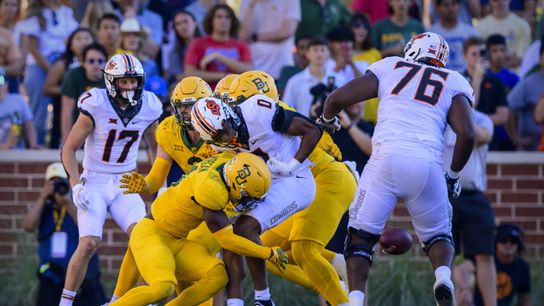Last August, Caleb Collins had a problem common to defensive coaches at every level of football. He wanted his unit to force more turnovers. And so Baylor's outside linebackers coach looked for inspiration in an uncommon place: the Texas penal code.
As the players walked in to the meeting room, a copy of Chapter 29 greeted them on the video board.
Specifically, Collins wanted to explain the nuance of Section 29.02, which reads as follows:
Sec 29.02. ROBBERY. (a) A person commits an offense, if in the course of committing theft as defined in Chapter 31 and with intent to obtain or maintain control of the property, he:
(1) intentionally, knowingly, or recklessly causes bodily injury to another; or
(2) intentionally or knowingly threatens or places another in fear of imminent bodily injury or death
(b) An offense under this section is a felony of the second degree.
"Theft is someone stealing my truck while I'm in here with you," Baylor defensive coordinator Matt Powledge explained during the Bears' coaching clinic on Friday night. "Robbery is them ripping the door open, yanking me out, and taking off with it."
In football terms, theft is picking up a loose football that just so happens to find its way to the turf. Robbery is the act of punching, poking, raking, deflecting, or just outright hitting the ball free, and then taking it. Robbery is good.
"It was about getting players to believe in it," Collins told me.
The day Collins introduced the topic, the Baylor defense turned the Baylor offense over four times. The a-ha moment came against Oklahoma in November, a game where the Bears allowed 499 yards and 35 points, but left Norman with a 38-35 win in large part because they intercepted Sooner quarterback Dillon Gabriel three times.
Baylor took things a step further this spring. Coaches drafted the defense into two teams, Jackers and Robbers, and award points based off the number and ways in which defenders get their hands on the ball.
"Players want to have something underneath the technique and the drills," head coach Dave Aranda said. "The ability that Caleb and Matt have to make it easily accessible is great."
Baylor's goal for 2023 is 30 turnovers and 40 sacks. The Bears turned opponents over 27 times and registered 44 sacks in 2021, making them the only defense in the nation to rank among the top 10 in both categories. Unsurprisingly, Baylor won the Big 12 and the Sugar Bowl, and Powledge was hired away as the co-defensive coordinator on Dan Lanning's new Oregon staff. In 2022, Baylor dipped to 19 turnovers and 24 sacks. The team's win total dipped from 12 to six.
The feeling in the building is that the disruption metrics will be back up in 2023, thanks in large part to a player-led emphasis. "Players will come up to me, 'Hey, Coach, I should have four more points. I batted a ball yesterday and you missed it,'" Collins said with a smile. "'Okay, find it on the film and let's watch it.'"
Additional notes:
-- Powledge coaches and monitors effort in three phases:
1) Seven seconds green. This is defined as playing with a "green light" for, you guessed it, seven seconds at a time. A green light means the player is playing at 100 miles per hour. Playing timid earns a player a yellow light. A red light? "Someone broke you," Powledge said.
2) A to B. This is simply the speed at which a player triggers from Point A to Point B.
3) +2. This means going two steps beyond what was required. A 10-yard sprint becomes a 12-yard sprint, for instance. The belief is that finishing two steps beyond the finish line will translate into defenders finishing through the ball carrier.
Furthermore, Baylor defines a loaf through seven different factors:
1) Staying on the ground.
2) A rush defender not turning and bursting to the ball.
3) Not sprinting to the football.
4) A change of speed on film, thereby proving the player was not operating at full speed throughout the play.
5) Getting passed up by a player.
6) Turning down a hit.
7) Not finishing aggressively at the end of a play.
"Do any one of these and you might as well be playing for the other team," Powledge said.
